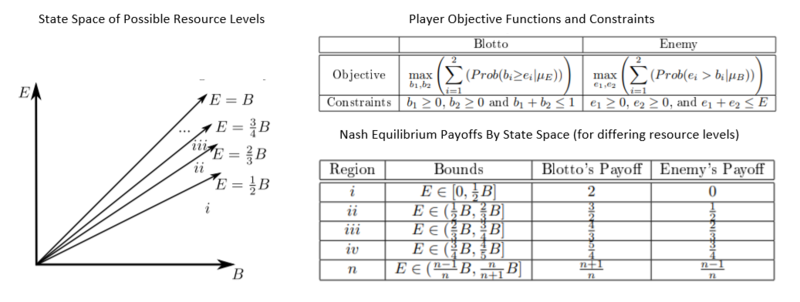Game theory is the study of mathematical models of strategic interactions among rational agents. It has applications in many fields of social science, used extensively in economics as well as in logic, systems science and computer science. Initially game theory addressed two-person zero-sum games, in which a participant's gains or losses are exactly balanced by the losses and gains of the other participant. In the 1950’s it was extended to the study of non zero-sum games and was eventually game applied to a wide range of behavioral relations, and is now an umbrella term for the science of rational decision making in humans, animals, as well as computers.
In game theory, the Nash equilibrium is the most commonly-used solution concept for non-cooperative games. A Nash equilibrium is a situation where no player could gain by changing their own strategy. The idea of Nash equilibrium dates back to the time of Cournot, who in 1838 applied it to his model of competition in an oligopoly.
The game of chicken, also known as the hawk-dove game or snowdrift game, is a model of conflict for two players in game theory. The principle of the game is that while the ideal outcome is for one player to yield, individuals try to avoid it out of pride, not wanting to look like "chickens." Each player taunts the other to increase the risk of shame in yielding. However, when one player yields, the conflict is avoided, and the game essentially ends.
In game theory, the best response is the strategy which produces the most favorable outcome for a player, taking other players' strategies as given. The concept of a best response is central to John Nash's best-known contribution, the Nash equilibrium, the point at which each player in a game has selected the best response to the other players' strategies.
A coordination game is a type of simultaneous game found in game theory. It describes the situation where a player will earn a higher payoff when they select the same course of action as another player. The game is not one of pure conflict, which results in multiple pure strategy Nash equilibria in which players choose matching strategies. Figure 1 shows a 2-player example.
In game theory, a player's strategy is any of the options which they choose in a setting where the optimal outcome depends not only on their own actions but on the actions of others. The discipline mainly concerns the action of a player in a game affecting the behavior or actions of other players. Some examples of "games" include chess, bridge, poker, monopoly, diplomacy or battleship. A player's strategy will determine the action which the player will take at any stage of the game. In studying game theory, economists enlist a more rational lens in analyzing decisions rather than the psychological or sociological perspectives taken when analyzing relationships between decisions of two or more parties in different disciplines.
In game theory, the battle of the sexes is a two-player coordination game that also involves elements of conflict. The game was introduced in 1957 by R. Duncan Luce and Howard Raiffa in their classic book, Games and Decisions. Some authors prefer to avoid assigning sexes to the players and instead use Players 1 and 2, and some refer to the game as Bach or Stravinsky, using two concerts as the two events. The game description here follows Luce and Raiffa's original story.
In game theory, a repeated game is an extensive form game that consists of a number of repetitions of some base game. The stage game is usually one of the well-studied 2-person games. Repeated games capture the idea that a player will have to take into account the impact of their current action on the future actions of other players; this impact is sometimes called their reputation. Single stage game or single shot game are names for non-repeated games.
In game theory, the outcome of a game is the ultimate result of a strategic interaction with one or more people, dependant on the choices made by all participants in a certain exchange. It represents the final payoff resulting from a set of actions that individuals can take within the context of the game. Outcomes are pivotal in determining the payoffs and expected utility for parties involved. Game theorists commonly study how the outcome of a game is determined and what factors affect it.
In game theory, a subgame perfect equilibrium is a refinement of a Nash equilibrium used in dynamic games. A strategy profile is a subgame perfect equilibrium if it represents a Nash equilibrium of every subgame of the original game. Informally, this means that at any point in the game, the players' behavior from that point onward should represent a Nash equilibrium of the continuation game, no matter what happened before. Every finite extensive game with perfect recall has a subgame perfect equilibrium. Perfect recall is a term introduced by Harold W. Kuhn in 1953 and "equivalent to the assertion that each player is allowed by the rules of the game to remember everything he knew at previous moves and all of his choices at those moves".
Equilibrium selection is a concept from game theory which seeks to address reasons for players of a game to select a certain equilibrium over another. The concept is especially relevant in evolutionary game theory, where the different methods of equilibrium selection respond to different ideas of what equilibria will be stable and persistent for one player to play even in the face of deviations of the other players. This is important because there are various equilibrium concepts, and for many particular concepts, such as the Nash equilibrium, many games have multiple equilibria.
In game theory, a game is said to be a potential game if the incentive of all players to change their strategy can be expressed using a single global function called the potential function. The concept originated in a 1996 paper by Dov Monderer and Lloyd Shapley.

In game theory, a simultaneous game or static game is a game where each player chooses their action without knowledge of the actions chosen by other players. Simultaneous games contrast with sequential games, which are played by the players taking turns. In other words, both players normally act at the same time in a simultaneous game. Even if the players do not act at the same time, both players are uninformed of each other's move while making their decisions. Normal form representations are usually used for simultaneous games. Given a continuous game, players will have different information sets if the game is simultaneous than if it is sequential because they have less information to act on at each step in the game. For example, in a two player continuous game that is sequential, the second player can act in response to the action taken by the first player. However, this is not possible in a simultaneous game where both players act at the same time.
In game theory, the price of stability (PoS) of a game is the ratio between the best objective function value of one of its equilibria and that of an optimal outcome. The PoS is relevant for games in which there is some objective authority that can influence the players a bit, and maybe help them converge to a good Nash equilibrium. When measuring how efficient a Nash equilibrium is in a specific game we often also talk about the price of anarchy (PoA), which is the ratio between the worst objective function value of one of its equilibria and that of an optimal outcome.
Congestion games (CG) are a class of games in game theory. They represent situations which commonly occur in roads, communication networks, oligopoly markets and natural habitats. There is a set of resources ; there are several players who need resources ; each player chooses a subset of these resources ; the delay in each resource is determined by the number of players choosing a subset that contains this resource. The cost of each player is the sum of delays among all resources he chooses. Naturally, each player wants to minimize his own delay; however, each player's choices impose a negative externality on the other players, which may lead to inefficient outcomes.
In algorithmic game theory, a succinct game or a succinctly representable game is a game which may be represented in a size much smaller than its normal form representation. Without placing constraints on player utilities, describing a game of players, each facing strategies, requires listing utility values. Even trivial algorithms are capable of finding a Nash equilibrium in a time polynomial in the length of such a large input. A succinct game is of polynomial type if in a game represented by a string of length n the number of players, as well as the number of strategies of each player, is bounded by a polynomial in n.

Jean-François Mertens was a Belgian game theorist and mathematical economist.
In game theory, Mertens stability is a solution concept used to predict the outcome of a non-cooperative game. A tentative definition of stability was proposed by Elon Kohlberg and Jean-François Mertens for games with finite numbers of players and strategies. Later, Mertens proposed a stronger definition that was elaborated further by Srihari Govindan and Mertens. This solution concept is now called Mertens stability, or just stability.

The Price of Anarchy (PoA) is a concept in game theory and mechanism design that measures how the social welfare of a system degrades due to selfish behavior of its agents. It has been studied extensively in various contexts, particularly in auctions.
The Berge equilibrium is a game theory solution concept named after the mathematician Claude Berge. It is similar to the standard Nash equilibrium, except that it aims to capture a type of altruism rather than purely non-cooperative play. Whereas a Nash equilibrium is a situation in which each player of a strategic game ensures that they personally will receive the highest payoff given other players' strategies, in a Berge equilibrium every player ensures that all other players will receive the highest payoff possible. Although Berge introduced the intuition for this equilibrium notion in 1957, it was only formally defined by Vladislav Iosifovich Zhukovskii in 1985, and it was not in widespread use until half a century after Berge originally developed it.



